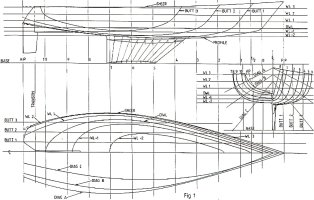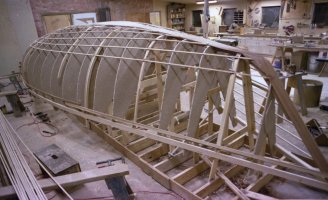Some implications here for the Bruce King choices in our designs. I call the Ericsons "tender," which is taken as criticism but not intended to be. The trade-offs are explained.
We all have favorite YouTube series, and I won't bore you (too much) with mine. But what Leo has accomplished is notable, and novelistic in scope and character. He is himself some transplanted primordial version of ineffable Englishness, nowhere more apparent than in the conversation with his naval architect. One imagines them on Dunkirk beach, having tea whilst being strafed and then coming back a year later in a new expeditionary force with dry socks to have a go at it again. Leo's primary helper has no feet, his feet having been run over by a railroad train in an earlier life. This rarely comes up as he bounds about the project on prostheses. Other workers project bonhomie and subtle Leo-mockery while doing jobs that by any definition are repetitive, awkward and endless. The Tally Ho project illustrates almost every boatbuilding skill now absolutely lost to time because supplanted by modern manufacture and materials. As resultthe inside of the boat looks like the inside of a Steinway. Behind the scenes, or between the lines as it were, lie personal lives roughly sketched, vast sums of money laid out (can Patreon really pay for all this?), woodworking tools and machines for purposes I didn't know exist, wood that must run $100 a linear foot, and a tone of indefatiguable carry-on-ness that is, ah, out of fashion.
YouTube didn't used to exist, don't you know. I think it is the premiere database of our time. I have learned more from it than any book or person, and it is insufficiently understood as a world-widening force.
We all have favorite YouTube series, and I won't bore you (too much) with mine. But what Leo has accomplished is notable, and novelistic in scope and character. He is himself some transplanted primordial version of ineffable Englishness, nowhere more apparent than in the conversation with his naval architect. One imagines them on Dunkirk beach, having tea whilst being strafed and then coming back a year later in a new expeditionary force with dry socks to have a go at it again. Leo's primary helper has no feet, his feet having been run over by a railroad train in an earlier life. This rarely comes up as he bounds about the project on prostheses. Other workers project bonhomie and subtle Leo-mockery while doing jobs that by any definition are repetitive, awkward and endless. The Tally Ho project illustrates almost every boatbuilding skill now absolutely lost to time because supplanted by modern manufacture and materials. As resultthe inside of the boat looks like the inside of a Steinway. Behind the scenes, or between the lines as it were, lie personal lives roughly sketched, vast sums of money laid out (can Patreon really pay for all this?), woodworking tools and machines for purposes I didn't know exist, wood that must run $100 a linear foot, and a tone of indefatiguable carry-on-ness that is, ah, out of fashion.
YouTube didn't used to exist, don't you know. I think it is the premiere database of our time. I have learned more from it than any book or person, and it is insufficiently understood as a world-widening force.


